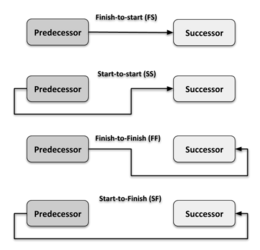Four types of dependency
Developed by Behzad Sanie
Contents |
Abstract
The precedence diagramming method (PDM) includes four types of independencies or logical relationships. [1] PDM is a tool for programming activities in planning a project. It is a method of constructing a network diagram of the project schedule that uses boxes, called nodes, to represent the activities and connects them with arrows that show the dependencies. PDM, In a network technology project, focuses on the precedence of activities and logical relationships. It is also known as the activity-on-node or AON and used by many project management software packages. PDM, In a network technology project, focuses on the precedence of activities and logical relationships. It is also known as the activity-on-node or AON and used by many project management software packages.
Types of dependencies
Four types of dependencies or logical relationship are linking predecessor activity and successor activity together in PDM. Predecessor activity comes before successor activity which is logically a depended activity in a schedule planning. Example: collecting data in a software project management is a predecessor activity and analysing the data is a successor activity. An activity must be time bound with a start and end time. This time bounding acquires the four types of dependencies between predecessor and successor which defined below:
- Finish-to-start (FS): A successor activity can start when a predecessor activity has finished. Example: building the walls (successor) in a house cannot start before finish the foundation (predecessor).
- Finish-to-finish (FF): A successor activity can finish when a predecessor activity has finished. Wall construction (predecessor) is required to finish before electrical wiring (successor) inside the walls can finish.
- Start-to-start (SS): A successor activity cannot start if a predecessor activity has not begun.
- Start-to-finish (SF): A successor activity cannot finish if a predecessor activity has not begun.
dependency determination
Dependencies identify by the following attributes:
- mandatory
- discretionary
- internal
- external
Reference
- ↑ Project Management Institute. (2013). A guide to the project management body of knowledge (PMBOK® Guide). 5th ed. Pennsylvania: Project Management Institute, pp. 156-159.
